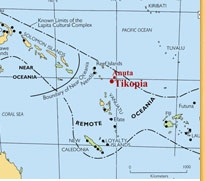The South Sea expedition ‘Lapita Voyage’ has fulfilled all its maritime and scientific aims. Four scientists joined parts of our expedition, while James Wharram and Hanneke Boon used the voyage for their studies of Polynesian/Pacific craft.
1. Archaeologist Dr. Eusebio Dizon (Philippines) who joined us on leg one had found ceramic potsherds at a site in the Philippines that bear similarities to ones we found on Kabacon Island (Duke of York Isl, Papua New Guinea). This so-called Lapita ceramic has been found at many sites in Near Oceania (Bismarck Isl. Solomon Isl. Vanuatu, New Caledonia, Fiji, Samoa, Tonga).
2. Under instruction of microbiologists Greger Larson (USA) and Professor Keith Dobney (UK) we collected nearly 150 hair/feather samples of Polynesian domestic animals (pigs, chickens, dogs) for DNA testing. These samples are going to be analysed in a laboratory at Durham University, England. They may finally prove (or disprove) that we have been on the correct migration route of the ancestors of the present day Polynesians.
3. Professor Atholl Andersen (New Zealand) has confirmed that potsherds found on the islands of Kabacon (Duke of York Isl., Papua New Guinea) and Te Motu (Santa Cruz Isl., Solomon Islands) were definitely Lapita ceramics. According to their decoration he dated them to approx. 3,000 years old. As a yachtsman, he also had a chance to gain first hand experience sailing a traditional double canoe along the migration route.
4. The Polynesian navigator Tulano Toloa (Tokelau Isl.) navigated the boat “Lapita Anuta” on the last leg of the voyage using traditional Pacific non-instrument navigation techniques on an open ocean stretch of 170 nautical miles from the island of Vanikolo to the tiny remote island of Anuta, continuing this non instrument navigation together with 5 extra Anutan crew on the 70Nm voyage to Tikopia, a total of 240Nm.
Unfortunately, due to the often difficult weather conditions and time constraints we were not able to navigate this way along the earlier part of the voyage.
5. James (Fellow of the Royal Geographical Society) and Hanneke studied the sailing abilities of the two double canoes, their traditional ‘Crabclaw’ sail rigs and steering paddles. They considered what drove the original migrating peoples to make these voyages, by first hand experiencing the conditions they would have encountered. They also collected design data of outrigger canoes still in use in the islands and compared this data with the data collected in the 1920-30s by Haddon and Hornell (Canoes of Oceania).













